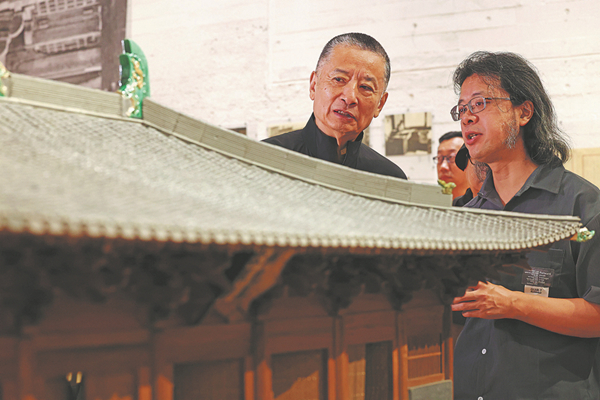A woman of her time, a leader of the ages
Updated: 2024-07-22
Recognition came too late, but it has changed perceptions of an architect who left an indelible mark on China, Hou Chenchen and Zhu Xingxin report in Taiyuan.

The delayed Bachelor of Architecture degree, issued to Lin by the Weitzman School of Design, University of Pennsylvania. ZHU XINGXIN/CHINA DAILY
For young Lin Huiyin (1904-1955) it truly was a case of being in the right place at the wrong time. The 20-year-old had traveled all the way from China to Pennsylvania, the United States, no mean feat in the early 1920s, to attend the US state's eponymous university. Lin's designs were clear: to realize a long-held desire to study architecture. However, there was one big problem: She was a woman.
Despite her obvious, laudable ambitions, the university's architecture program under its school of fine arts summarily rejected her application on those very grounds.
However, its school of fine arts was a little more relaxed, and Lin would enroll there, completing all her courses over the years – including compulsory ones in architecture – with one notable exception. The university's regulations did not countenance women doing live figure drawing, on the grounds that it would expose them to the male body.

Guests attend the exhibition, including Liang Jian (left in middle photo), grandson of architects Lin Huiyin and Liang Sicheng. ZHU XINGXIN/CHINA DAILY
It would not be until 10 years later, in 1934, that more enlightened attitudes would prevail and women were able to take their rightful place in the architecture program, but of course for Lin it was too late.
Lin is widely known in China, not for her architectural talent, but as a prominent figure in novels and television dramas that depict her as a poet and as a romantic heroine.
Last month, a century after Lin began her studies in Pennsylvania, her granddaughter Yu Kui arrived in Shanxi province, where her late grandmother did research, with a special document in hand: the architectural degree for which Lin had worked so assiduously, but which she had been denied. In May, recognizing this historic injustice, the University of Pennsylvania publicly and posthumously bestowed on Lin the degree she so richly deserved.

Visitors to the Liang Sicheng and Lin Huiyin Academic Document Exhibition at the Changjiang Art Museum in Taiyuan, Shanxi province, in June. ZHU XINGXIN/CHINA DAILY
One reason Yu had brought the prized document was to deliver it to the Liang Sicheng and Lin Huiyin Academic Document Exhibition in Foguang Temple, Wutai county, Xinzhou, and to the Changjiang Art Museum in Taiyuan, both in Shanxi province. The temple played a key role in Lin's studies, as it was the subject of a well-known architectural survey she undertook with her husband Liang Sicheng (1901-1972). Also on display in both exhibitions is a manuscript of hers dated June 29, 1937, that details the work.
As Lin and Liang surveyed the wooden temple in 1937, her keen eye picked out faint inscriptions beneath the main beam, providing crucial evidence of the building's age, her son Liang Congjie wrote in his article, Reminiscing About My Mother Lin Huiyin, in 1987.

Visitors showing great interest in research documents by Lin Huiyin and Liang Sicheng and their architectural drawings and sketches at the exhibition. ZHU XINGXIN/CHINA DAILY
Wang Nan, senior engineer at the Palace Museum in Beijing, and one of the curators of the exhibitions, says recognition of Lin's discovery represented the first time that she had been allowed to stand on the same academic and intellectual pedestal as her husband.
"Liang is often regarded as the father of modern Chinese architecture, and a common misconception is that he sparked in her an interest in architecture. With the discovery of more records, and Lin's manuscripts, her outstanding contribution to architectural history becomes evident."
In a paper published last year in the journal Modern Science, researcher Meng Zhaoyuan analyzed media coverage of Lin over the past century, in which she is often portrayed as a member of the literati and an activist, overlooking her identity as an architectural scholar. In fact in newspaper reports over the decades, mentions of her beauty and romantic life very much eclipse other things.

Guests attend the exhibition ZHU XINGXIN/CHINA DAILY
On June 10, the 120th anniversary of Lin's birth, the architecture program at the University of Pennsylvania, which is now under the Weitzman School of Design, put everything in its correct perspective. At its annual graduation ceremony, it awarded Lin, who died in 1955, a Bachelor of Architecture degree in recognition of her pioneering contributions to Chinese architecture.
"All the men from China received full scholarships and Lin got half of one. She was the only woman and the only student who wasn't allowed to get an architecture degree," Dean Fritz Steiner said.
"My mother had a strong sense of freedom," Liang Congjie wrote in his article. "Even though she was a university teacher, published articles and was famous, she was stripped of her own identity and simply regarded as Liang Sicheng's wife."
Su Dan, deputy director of the China National Arts and Crafts Museum in Beijing, says that it was through Hou Youbin, a disciple of Lin and Liang Sicheng, and an expert in ancient Chinese architectural history, that he first got wind of Foguang Temple. Over the course of 40 years, Su says that he visited the temple countless times and retraced the couple's steps as they explored ancient buildings.
"Generations of Chinese architects grew up heavily influenced by the couple," Wang says. "I have visited Shanxi many times, far more than even they did, yet everything I do is rooted in their work."

Visitors showing great interest in research documents by Lin Huiyin and Liang Sicheng and their architectural drawings and sketches at the exhibition. ZHU XINGXIN/CHINA DAILY
Shanxi is a repository of ancient Chinese architecture, and is home to more than 80 percent of the ancient wooden buildings of the Yuan Dynasty (1271-1368) and earlier. Yet, the couple visited the province just four times.
In July 1937, as they left Foguang Temple, they received news of the Marco Polo Bridge Incident in Beijing, marking the full-scale outbreak of the Chinese people's War of Resistance Against Japanese Aggression (1931-45). Amid national turmoil they threw themselves into protecting ancient buildings.
By that time, young women who studied architecture at Pennsylvania University were finally able to treasure their diplomas, a joy Lin never experienced.
After her death, she was buried at the Babaoshan Revolutionary Cemetery in Beijing, which she designed, taking a revered place with many other important figures of modern Chinese history.
The words that her husband Liang Sicheng chose to inscribe on her tombstone could be no simpler, nor more fitting – "Lin Huiyin, architect".



